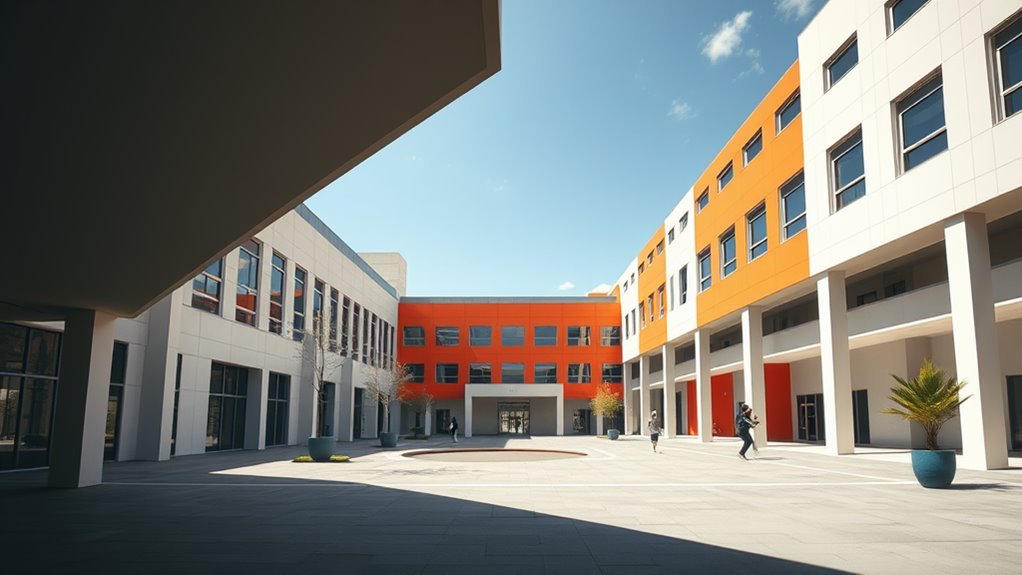Free education sounds great, right? Well, it has ups and downs. On the plus side, it opens doors for more people to go to college, which can boost the economy and create a smarter workforce. But it doesn’t come cheap! Taxpayers might feel the pinch, and there could be fewer resources for schools, making classes bigger and less personal. It’s a balance between helping everyone get an education and managing costs. Stick around, and you’ll find out more!
Main Points
- Equal Access: Free education removes financial barriers, promoting equal access to higher education for diverse groups and enhancing workforce skills.
- Economic Growth: A more educated population boosts earnings, increases tax contributions, and stimulates local economies through greater disposable income.
- Taxpayer Concerns: Funding free education could lead to increased taxes, financial burdens on taxpayers, and potential cuts to essential public services.
- Quality of Education: Overcrowding from higher enrollment may diminish the quality of education, impacting student motivation and personal attention from faculty.
- Implementation Challenges: Historical attempts at free college have faced skepticism, and balancing funding with educational access remains a complex issue.
Is College a Human Right?
Is college really a human right? This question sparks heated discussions. The United Nations does acknowledge education as a fundamental human right, which includes higher education.
Many believe that free college programs could pave the way for better access to education, especially for those in low-income communities. Thrillingly, countries like Germany and Finland show that when college is free, student debt shrinks, and enrollment rates soar!
Nevertheless, the economic consequences can be tricky. Some worry that funding these programs might lead to overcrowded schools and lower quality education.
Pro #1. Equal Access to Education
While many dream of attending college, the reality is that financial hurdles can make it seem like an unattainable goal for some.
Free college education can help smash those financial barriers, giving equal access to higher education for all students, especially those from low-income and underrepresented backgrounds.
In fact, polls show that a whopping 78% of Americans support free college initiatives, proving it’s a popular idea.
With over 30 states offering free community college and programs like New Mexico’s Opportunity Scholarship, more students can enroll, leading to greater diversity on campuses.
This means a richer, more inclusive environment where everyone can learn from each other, regardless of their socioeconomic background.
Now, that’s something worth celebrating!
Con #1. Funding Sources Remain Unclear
Free college education sounds like a dream come true for many students, especially those who face financial challenges.
Nevertheless, the reality is a bit murky when it comes to funding sources. Implementing these programs requires substantial funding, which often means taxpayers might feel a pinch in their wallets.
Imagine facing an average cost of $3,000 per adult taxpayer in states with free college! Funding mechanisms differ, with some individuals suggesting a speculation tax could help.
But without clear and consistent financing, the quality of education could suffer. States may also lose important tuition revenue, making it essential for government resources to step in.
In the end, the effectiveness of free college hinges on solid funding streams, which remain unclear at best.
Pro #2. Economic Growth Through Education

Many people might not realize just how much economic growth can sprout from a well-educated workforce. When individuals receive higher education, they typically earn more money and contribute considerably in taxes throughout their lives. Each college graduate adds about $381,000 to society, which is a pretty impressive number!
Plus, when higher education becomes accessible, it helps close the achievement gap and racial wealth disparities, leading to a more balanced economy. With reduced tuition costs, graduates can dodge hefty student debt and spend their money on goods and services, boosting local and national economies.
In the end, a more educated population means a more skilled workforce, driving innovation and fueling economic growth for everyone.
Con #2. Taxpayer Burden Increases Significantly
When it comes to the idea of free college education, the price tag can be quite a shocker! Implementing such a program could cost taxpayers around $500 billion over ten years. Yikes!
This substantial funding requirement means increased taxes, which could lead to a heavier financial burden on citizens. As states step in to subsidize free tuition, essential public services might face cuts. Imagine needing to fix potholes, but the budget is tight because of education funding!
Plus, if more students enroll, the demand for resources skyrockets, straining these budgets even further. The reliance on taxpayer dollars raises serious questions about sustainability, especially during tough economic times when state revenues might decline.
It’s a tricky situation!
Pro #3. Reduced Financial Stress for Families
With the hefty price tag of free college education looming large over taxpayers, it’s easy to overlook the brighter side of the equation.
Free college tuition can markedly reduce financial stress for families. Instead of worrying about skyrocketing tuition costs, parents can focus on other essential needs, like groceries or that long-awaited family vacation. By eliminating tuition fees, families can save between $10,000 to $30,000 each year for each child in college.
This means less student loan debt and fewer financial burdens, creating a sense of relief and peace of mind. Additionally, access to free college could open doors for low-income families, helping to bridge the wealth gap.
In this way, free education can be a game-changer for many.
Con #3. Quality of Education Declines

While the idea of free education sounds fantastic, it can lead to some serious challenges regarding the quality of learning.
With more students flocking to colleges and universities, overcrowding becomes a major issue. This surge can stretch resources thin, resulting in larger class sizes and lower faculty-to-student ratios. As a result, students may not receive the personal attention they need, which can hurt academic standards.
Plus, schools might cut costs, sacrificing essential programs and activities that enrich education.
Curiously, when education is perceived as “free,” some students may feel less motivated, thinking, “Why bother?” This mindset can diminish the value placed on their education, eventually affecting the quality of education they receive.
Pro #4. Increased Enrollment in Diverse Fields
How can free education open the door to a world of possibilities? With no tuition fees, students can investigate diverse fields that truly spark their interests, from the arts to social sciences.
This newfound freedom means they can choose majors that excite them, leading to greater satisfaction and engagement in their studies.
Plus, studies show that free education helps break down financial barriers, encouraging more underrepresented groups to join various disciplines.
As a result, increased enrollment in diverse fields can create a richer, more groundbreaking workforce.
In turn, this diversity nurtures creativity, which can boost economic growth and societal development.
Con #4. Increased Competition for Admissions
As free education becomes more accessible, the competition for college admissions is heating up faster than a hot summer day!
With more prospective students vying for spots in public universities, increased competition is the name of the game. This surge in applicants might lead to stricter admission criteria, making selectivity a hot topic.
Students are now pushing themselves to achieve higher GPAs and test scores, hoping to stand out in a crowded field.
Nevertheless, this heightened competition poses challenges, especially for students from underrepresented backgrounds, who may find it harder to secure a spot.
While free education aims to enhance equity, the reality of admissions may complicate those dreams, leaving some feeling like they’re running a marathon with a boulder on their backs!
Pro #5. Stronger Job Market Outcomes

Increased competition for college admissions isn’t the only thing stirring up excitement in the world of education; the promise of free college education also brings a wave of potential job market benefits.
With more people earning degrees, the job market becomes stronger. College graduates earn markedly higher wages than their high school counterparts, contributing to economic growth. This educated workforce can spark technological innovations and boost productivity, making businesses more competitive.
Plus, free college helps underrepresented groups access better job opportunities, closing the achievement gap. As college attendance rates rise, the result is a more skilled workforce, leading to lower unemployment rates and a more stable job market.
Everyone benefits when education is accessible!
Con #5. Taxpayer Resistance to Funding
What happens when the idea of free education meets the reality of taxpayer wallets? Taxpayer resistance often kicks in, especially when individuals realize the financial consequences of funding such programs.
Many fear that free education means tax hikes that could squeeze their budgets. In states with free community college, some taxpayers worry about the money being taken from essential services like healthcare or infrastructure.
While polls show strong support for free college, that enthusiasm cools when the potential costs are discussed. Critics also raise concerns about equitable funding—why should taxpayers support education for wealthier students or those who may not finish their degrees?
The balancing act between good intentions and financial realities makes this a tricky topic.
Pro #6. Stimulates Local Business Growth
While some taxpayers might grumble about the costs of free education, there’s a silver lining that could brighten their outlook: local business growth.
When communities offer free education, they boost the number of college graduates, creating a skilled workforce. This attracts businesses keen for qualified employees.
Plus, with less student debt, graduates have more disposable income to spend in local economies, which means more cash flowing into shops and restaurants.
Higher education often leads to better earnings, raising total income levels and benefiting local businesses.
In addition, educated individuals are more likely to start their own ventures, sparking innovation and contributing to economic development.
In short, free education can be a powerful engine for local business growth and community prosperity.
Con #6. Taxpayer Funding May Decrease

When the idea of free education comes up, many people might picture happy students celebrating their debt-free futures, but there’s a less cheerful side that deserves attention: the impact on taxpayers.
Implementing free college education would require massive taxpayer funding, which could mean increased taxes for everyone, from hardworking individuals to local businesses.
Estimates show that covering the costs could run into billions annually, raising eyebrows over whether such programs are sustainable.
With states losing tuition revenue, public budgets might take a hit, leading to a financial burden on taxpayers. This could mean fewer public services or even higher local taxes.
In short, while free education sounds great, the cost could leave taxpayers feeling a bit less cheerful.
Pro #7. Increased Innovation and Creativity
Free college education opens the door to a world of possibilities, sparking innovation and creativity like a match to dry grass. With no hefty tuition bills weighing them down, students can engage in diverse fields, exploring creative solutions that push boundaries.
This freedom encourages entrepreneurial ventures, where bright minds can take risks and launch new ideas. A well-educated population leads to more patents and research publications, showcasing a surge in increased innovation.
Plus, studies show that access to education sharpens problem-solving skills, as students collaborate across disciplines. When different viewpoints come together, magic happens!
The vibrant academic environment becomes a breeding ground for original thoughts and advancements, fueling excitement for the future. Who knows? The next big invention could come from a free college classroom!
Con #7. Increased Enrollment Strains Resources
As college education becomes more accessible, the number of students enrolling skyrockets, which might sound great at first, but it does come with a few hiccups.
Increased enrollment can lead to overcrowded classrooms, where students often feel lost in the crowd. This means less individual attention from faculty, which is essential for learning.
Plus, colleges may struggle to keep up, resulting in long wait times for course registration and fewer available classes.
When campus facilities like libraries and dining areas are packed, the general student experience takes a hit.
Maintaining educational standards becomes tough when resources are stretched thin.
In the end, while more students get a shot at education, the quality of that education might just suffer.
Pro #8. Enhanced Global Competitiveness

Education plays a crucial role in a nation’s global competitiveness, and providing access to free education can be a game-changer. Countries like Germany and Finland have shown that free college leads to a highly skilled workforce, boosting productivity and innovation.
Imagine a world where students can immerse themselves in STEM fields without drowning in debt! This financial relief opens doors for diverse talent, sparking creativity and fresh ideas that fuel economic growth.
An educated populace also tends to venture into entrepreneurship, launching businesses that create jobs and keep the economy buzzing. By investing in free education, nations not only prepare their citizens for the future but also position themselves as strong competitors on the global stage.
Now, that’s something worth celebrating!
Con #8. Increased Taxes for Citizens
When considering the idea of free college education, many people might overlook a notable detail: the potential increase in taxes for everyday citizens.
Implementing free college programs could cost up to $60 billion annually, which means increased taxes for funding. This might hit the middle class the hardest, as they would likely shoulder a larger share of the tax burden.
Wealthier students, who don’t really need financial help, could benefit without contributing as much. Some suggest a speculation tax to raise funds, but that idea faces pushback, especially from investors worried about market effects.
Plus, states offering free college might need to hike state taxes too, raising concerns about the long-term sustainability of such initiatives.
Pro #9. Boosts Lifelong Learning Opportunities
Imagine a world where anyone, regardless of their financial situation, can immerse themselves in learning new skills or exploring different fields of study without worrying about hefty tuition fees.
Free education opens the door to lifelong learning opportunities, breaking down financial barriers that often hold individuals back. This means more people can jump into adult education programs, helping create a skilled workforce ready to tackle the challenges of tomorrow.
Research shows that when financial pressures are lifted, individuals are more likely to pursue advanced degrees, boosting their personal and professional growth.
Plus, free education encourages exploration of diverse studies, nurturing innovation and contributing to economic growth.
Simply put, it’s a win-win for everyone involved!
Con #9. Taxpayer Funding for Free Education

Free education sounds fantastic, right? Nevertheless, it often comes with a hefty price tag that relies on taxpayer funding. This can mean tax increases, potentially costing each adult taxpayer thousands of dollars annually.
Critics worry about the sustainability of such programs, as government budgets may become strained, diverting funds from essential services like healthcare and roads. Additionally, with states losing tuition revenue, they might need to provide subsidies to keep colleges running smoothly.
While some argue that an educated workforce brings economic benefits, others question whether the financial burden on taxpayers is worth it, especially when maintaining education quality could become a challenge.
Balancing these factors is no easy feat, making the conversation around free education quite complex.
Pro #10. Encourages Lifelong Learning
Education has always been a key to opening doors, and the idea of free education takes that concept to a whole new level. By eliminating financial burdens, free education encourages lifelong learning, allowing individuals to pursue further studies with ease.
This means that more people can immerse themselves in new skills and certifications, boosting their employability. Studies reveal that access to free education leads to higher rates of adult education participation, making it easier for graduates to adjust in today’s fast-paced job market.
When lifelong learning is embraced, it creates a more skilled workforce, which is essential for innovation and economic growth.
Con #10. Reduced Funding for Adult Education
While the idea of making college tuition-free sounds great on the surface, it can come with some unexpected consequences, especially for adult learners.
Free college initiatives might pull funding away from adult education programs, leaving many in the lurch. Adult education is essential for marginalized communities who often need vocational training to boost their skills and job prospects.
If funds shift towards traditional college, those important programs could face cuts, impacting workforce development. A report even shows that adult education funding has been slipping in recent years, which is worrisome.
With nearly 2.7 million adults relying on these programs, it becomes clear that supporting lifelong learning for everyone is significant, not just for new college students.
Historical Context of Education Funding

Back in the day, higher education was like an exclusive club, where only the wealthy had the golden ticket to enter. For a long time, access to higher education was limited, leaving many people out in the cold.
Then came the G.I. Bill in 1944, which changed the game by providing funding for veterans, highlighting the importance of government involvement in education funding.
The 1960s and 1970s saw states experimenting with free or low-cost college options, leading to more graduates and a smarter workforce.
But by the late 20th century, rising tuition costs and student debt began to cast a shadow over those achievements.
Countries like Germany and Finland have shown that education can be a public good, sparking debates on similar ideas in the U.S.
Final Thoughts
The idea of free college education stirs up a mix of hope and skepticism. Advocates argue it could wipe out student loans and save families a staggering $177 billion by 2030. Imagine that!
Plus, it might help close the achievement gap, making higher education more accessible to everyone. Higher graduation rates could follow, as financial stress often leads to dropouts.
Nevertheless, there’s a catch. Funding sources could become a real headache. Straining government budgets might mean higher taxes or shifting money from other important areas.
While the economic benefits of free college are clear—each grad contributing around $381,000 to society—the path to implementing such programs demands careful thought.
Free college sounds great, but it’s not as simple as it seems.
Resources
Should College Be Free? The Economic Impact of Free Tuition: Analyzes economic effects of free college tuition.
Why ‘Free College’ is a Terrible Idea: Critiques potential drawbacks of free college policies.
The Pros and Cons of ‘Free College’ and ‘College Promise’ Programs: Summarizes research on free college initiatives.
The Pros and Cons of Having Free College Education for All: Discusses benefits and drawbacks of universal free college.
Free Education: Pro and Contra: Investigates arguments for and against free education.
Should College Be Free: Pros and Cons: Explores advantages and disadvantages of free college.
What’s Wrong with Tuition-Free Four-Year Public College?: Examines potential issues with tuition-free public colleges.
The Promise of Free College (and Its Potential Pitfalls): Analyzes benefits and challenges of free college programs.
Cost-Free Education as a New Variable of Mixed Financing Policies in Chilean Higher Education: Studies effects of free education in Chile’s higher education system.
Open Educational Resources: Discusses advantages and challenges of open educational resources.




